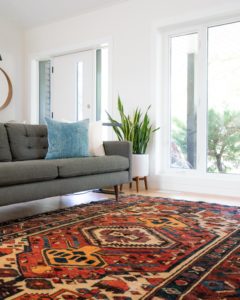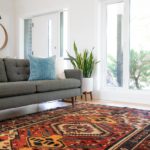Oriental Rug & Area Rug Care Tips

Vacuum regularly.
This is the best maintenance you can perform to keep your rugs in great shape in between cleanings. Think of all the dust that daily settles on to your hard floors … that same dust settles on your rugs and needs to be removed also, otherwise it works its way into the fibers and causes damage you cannot correct. Vacuum WITH, not against, the nap of the rug’s “fuzzy” side. The rug’s fibers are similar to your pet’s fur – you know, when you are petting with the nap, and when you are not. Going “with the nap” causes less friction. Entry rugs with high traffic should be vacuumed at least twice a week. Rugs with moderate traffic should be vacuumed weekly. Even rugs in areas with no traffic will still have dust settling on them daily, so attend to them bi weekly. A consistent vacuuming routine will help keep your rugs cleaner and healthier longer. Learn more about vacuuming wool rugs at RugChick.com.
Rotate your rugs.
Rotate rugs to even out any possible sun fading, and to also not allow one specific area to get all the foot traffic wear. Rotate small rugs every 3-6 months; larger rugs every time it goes for a bath put it back down the opposite direction.
Inspect your rugs for bugs.
Quarterly you want to inspect your rugs closely for any insect activity. Moths and carpet beetles generally begin feasting in areas that have little light and little air flow – this means they prefer the BACK of the rug, or places under furniture. The larva looks like “sticky lint”, so flip over the corners of the rug to see if you have any activity. American Indian weavings hanging on the wall are particularly vulnerable, so take them down bi-annually to shake and dust them, and look for bugs.
Inspect your rugs for needed repairs.
You also want to check the ends and sides of your rugs to make sure that they are not in need of repair. When fringe tassels become worn and torn, the wool or silk knots of the rug begin to pull away from the rug, and if this is caught early it is a much cheaper repair than reweaving a section of the rug down the road. Look at the BACK of the rug to clearly see if all the knots are tightly and securely in place. For rug repairs locally, we recommend Aarons Oriental Rug Gallery.
Protect your rugs.
Many newer rugs, especially Chinese rugs, are chemically washed to give them a nice “sheen.” This chemical process makes these rugs sensitive to sunlight and they will fade in a period of just a few short years. If this concerns you, consider treating your windows with a UV-filter coating, or use thicker window coverings to block out the rays during peak hours.
Never use carpet spot removers or baking soda on your rugs.
Folex® and Resolve® are meant for SYNTHETIC carpet, and not wool or silk rugs. These chemicals (and even Woolite®) are too strong to use on rugs and they will either cause a chemical discoloration or it will bleach out the rug dyes completely. Baking Soda also causes damage by yellowing the fibers. This damage is permanent, and will devalue your rug, so please stick to Club Soda.
Never put potted live plants, or plastic protectors, on top of your rugs.
Even careful plant caretakers spill a bit when watering plants. This water seeps into the cotton foundation which leads to mildew growth and dry rot. Plastic protectors also inhibit airflow and can cause mildew growth and dry rot. When dry rot sets in, eventually the rug falls apart in that area of rot. It ruins the rug.
If a lot of dirt seems to be collecting on the rug – like on your entryway rugs – then turn these rugs fuzzy side down and run an upright beater bar vacuum along the back side.
Stay away from the fringe tassels or you’ll suck them up. This “shakes” the dirt out of the base of the rug’s foundation, and then you can flip the rug over and vacuum away all of the dust, dirt, and allergens.
How To Remove Visible Spots & Stains On Rugs
Liquid Spill
Immediately blot with cotton towel. Do not scrub the fibers or they can become distorted and damaged.
Non-Liquid Spill
Immediately scrape up material with spoon and blot with cotton towel.
Check the towel for two things:
- Is the spill absorbing into the towel?
- Are any of the rug dyes absorbing into the towel?
If the rug dyes are absorbing into the towel, blot a bit more and then STOP.
No more work can be done to this area without causing the dyes to bleed together. This type of damage can devalue your rug, so it is important to stop before any more damage is done.
If the rug dyes are not absorbing into the towel (only the spill is seen), then place a folded towel underneath the affected area.
Take a bowl of Club Soda and use a sponge to get the location of the spill wet again. Try not to get it soaking wet, just wet enough so the fibers are damp. Why club soda? It helps to keep the spill “suspended” so you can grab it with the cotton towel when you blot.
Take a new towel and blot the top of the rug.
This will continue pulling out the spill from the fibers.
When no more spill material is visible in the towel, create a “sandwich.”
With a folded towel under the spill and one on top, and either stand on this area or put heavy books on it for 10-15 minutes.
Remove the towels and elevate the damp area so that it can dry completely.
Most rugs have a cotton foundation which is very absorbent, so you have to be absolutely certain this “skeleton” of your rug is 100% dry so mildew will not grow. Use a hair dryer on cool or warm setting on the front AND back of the rug to help quicken the process. Or keep the rug propped up to “air dry” for at least 24 hours for a small spill and longer for larger ones or if your rug is thick.
Pet Urine Spots on Rugs
- A different set of problems arises with “old” pet urine stains. When a pet urine stain is “fresh” it is a strong acid stain. After it has dried completely, and has sat in the fibers for several days, it becomes a strong alkaline stain. The problem with high alkalinity and wool is that it yellows the wool, and it also counteracts the mordant process that holds the dyes on to the wool fibers. It essentially makes the dyes “dissolve.” Even a rug with colorfast dyes will bleed and fade in areas that have old pet urine stains. So, the key in handling all pet stains is getting to the area as soon as you can.
- Of all the possible spills to happen to your rugs, pet urine and pet vomit are the worst. Because they go on hot and acidic, they actually re-dye the fibers, and “set” them at the same time – so if you are not quick these will become permanent stains that will devalue your rug. You need to follow the spill steps: blot, rinse, blot. If the rug has dyes that show up in the towel in the first blotting step, then substitute a 50/50 white vinegar and water mixture for the Club Soda AND get the area only slightly damp – NOT wet. For pet feces, you must pick up as much as you can before you begin the Club Soda process.
Pet Urine Odors on Rugs
- To remove odors associated with all of these pet “emergencies,” misting Nature’s Miracle® on the areas helps to remove some of the odor-causing bacteria. Resist the urge to saturate the rug with Nature’s Miracle®, because pouring any product on a rug is never a good idea. With pet urine, if it is a substantial amount then it has penetrated the wool or silk fibers and has been absorbed into the rug’s cotton foundation. In this case, the only way you will be able to remove the odor will be to give the rug a full immersion ‘bath.’ Distinctive has the necessary tools and solutions to eliminate pet urine odor from your valuable rug. Learn more about our Pet Spot & Pet Urine Odor Removal Process here.
Professional Cleaning & Washing of Rugs
- Your need for professional cleaning will vary with how much traffic your rugs are getting and how often they are being vacuumed. The general rule of thumb for rugs under normal use is that they should be given a thorough cleaning every two years. The longer you wait in between cleaning, the more wear will result from abrasive grit working its way down into the base of your rug and literally cutting at the fibers. Cleaning will also remove the allergens, bacteria, dirt and other unmentionables that collect in the rug over time.
- Learn more about our Rug Cleaning & Washing Services in Fort Wayne. Call Distinctive at 260-250-4664 to schedule a thorough cleaning of your precious rugs. Get your no-obligation, hassle-free estimate here.
Rug Pad Tips
- If you are placing a rug over a hard surface such as stone, wood or tile we offer WunderGRIP™ Rug Pad!
- Handmade rugs should NOT have a big, soft, spongy pad. In a handmade rug, the cotton foundation that runs through the inside of the rug needs firm support to keep the structural integrity in place. If you put a soft, spongy pad under it, it will cause far too much stress on the foundation, and will ultimately cause damage.
Good Reasons to Use A Quality Rug Pad - To Keep Rug in Place
- To Give Support
- As a Moisture Barrier Between Rug and Floor
- To Discourage Insect Activity
Even if your rug is anchored in one place (by a couch or other heavy piece of furniture), the rest of the rug will crawl around without a pad.
A pad will help anchor the remainder of the rug more firmly, to discourage any potential damage that might be caused by creeping, pulling and stretching rugs.
Pads for rugs on top of wall-to-wall carpet don’t work well.
This gets back to the issue of having something springy or cushioned under the rug. There is no avoiding this with a wall-to-wall carpet as the base. Even the firmest, thickest pads reportedly designed for use on wall-to-wall carpet are only occasionally effective. Our experience is that these pads simply are not effective enough to be recommended. Avoid laying your carpets on wall-to-wall carpeting if at all possible.
The most important thing our WunderGRIP™ Rug Pad does is protect the life of your rugs, preventing premature wear which shows up in heavy traffic areas as troughs or “valleys.”
Rugs are meant to be on a “hard” surface, and a pad should be sturdy so that it acts as a “shock absorber” to foot traffic. The more “cushion” you have, the more strain you will cause to your rugs. Solid rug pads lengthen the life of your rugs substantially, as mechanical wear tests have repeatedly demonstrated.
Area rugs laid directly on bare floors are hard and will wear out quickly.
But a feel that is too soft and squishy means your area rugs are still in danger. Soft area rug pads such as foam permit too much flexing of your area rugs, destroying your area rugs foundation and backing causing seams to rip open on area rugs custom made from wall-to-wall carpeting. Soft area rug padding also accelerates damage from furniture legs and traffic, particularly heels. Think of it this way. You can write on a pad of paper, but it’s impossible to write on a piece of paper over a pillow, because all it does is tear and puncture.
The right type of pad underneath your rug provides many benefits from keeping it from slipping on the floor or buckling.
It can act as a “shock absorber” for foot traffic to lessen the wear on the rug’s fibers.
Rug pads cannot be cleaned.
Or technically, some can be cleaned, but the cleaning process will render the pad ineffective. Animal activity can ruin a pad. A pet urinates on the rug; it will likely soak through the rug and into the pad. If you have pets, use cheap, disposable pads and change them every year. Better pads are made from better materials and cost more – but they last longer, we recommend our WunderGRIP™ Rug Pad. Use higher-quality pads, like WunderGRIP™ Rug Pad, only if there are no pets in the house. There’s no sense in buying a quality pad only to have to dispose of it if/when your pet causes an accident on it.
Rug Storage Tips
Insect damage, flood or mildew damage, and theft are the most common problems we hear from clients who have placed rugs in a local storage unit or placed in a far corner of a closet or garage. Many times, rugs with high appraised or sentimental value are placed in storage to save them for family members, or to save them from a remodel mess, or to protect them from the summer sunlight. You want to make sure you are not actually causing damage by incorporating the wrong storage procedures.
Clean rugs before wrapping for storage.
The first, most important piece of storage advice is to always store rugs clean. Never wrap up dirty rugs. Have them washed properly and then prepared for storage, otherwise there’s a chance you’ll wrap hungry little rug-snacking critters in with your rug in a nice, protected environment, and in a year or more, when you open it up again, you could be in for an ugly, expensive surprise.You must clean your rugs of food and liquid material because though moths are normally the storage “bad guys” – ANY insect will eat sugars and other food materials, and they will eat the wool fibers that are holding this meal for them too.
Roll your rugs starting at the bottom end to the top end, fuzzy side inside.
To find the bottom end of your rug, you want to “pet” your rug to determine when you are going WITH the nap, and AGAINST the nap. When you run your hand WITH the grain, it will take you to the tassels of the bottom of the rug (where the weaver began weaving your rug). Roll from this end. Folding rugs causes cracking over time, so do not fold rugs being put in storage.
Roll your silk rugs with the fuzzy side outside.
Wool and cotton rugs have more “give” to them than silk rugs, so when placing silk rugs into storage, roll them with their fuzzy silk side outside.
Wrap your rugs in Tyvek or brown acid-free paper.
Wool has a moisture content even when it is dry, so changes in heat will cause it to “sweat.” Because of this you should never wrap wool rugs in plastic or you will create a mildew problem. Tyvek Paper is best because it is tear and water resistant.
Elevate your rug packages off of the ground.
Many storage facilities are built in lowlands that have a tendency to flood during bad weather, so whether in your home or their location you always want to keep rugs at least six inches off the ground in case water damage or flooding occurs.
Make sure nothing heavy is stacked on top of your rugs.
Heavy items can cause damage to the rug’s foundation.
Get the proper insurance to protect your rugs when placed in a storage facility.
You also want a photograph and appraisal on file in case you need them.
- Find more rug storage tips at RugChick.com.





